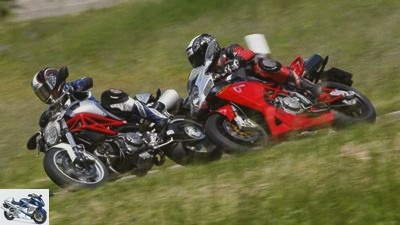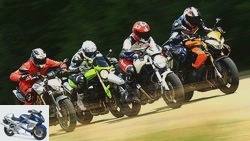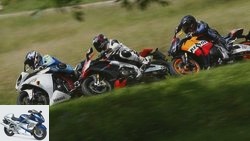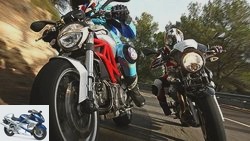Menus

K
Bimota DB5 S, Ducati Monster 1100
Who convinces on the country road?
Content of
Lush dimensions, well-formed, beguiling and doubly present: Ducati’s 1100 DS engine drives not only the big monsters but also Bimota’s DB5 S, a true super sports car. How do the bikes implement the qualities of the two-valve engine??
A dull rumble sounds over the Swabian Alb. Ducati Monster 1100 and Bimota DB5 S sweep low through the winding curves; they drive out whichever is better suited for well-maintained country road heating. At first glance, the unequal couple have one thing in common: their drive. An equally lively and gentle middle class V2 from Bologna with 1079 cm³ displacement, 90 HP rated power and a little over 100 Nm torque. The 1100 two-valve engine debuted in the Ducati Multistrada at the beginning of 2007, a little later Ducati implanted it, slightly modified, in the Hypermotard; this expansion stage also fires the Bimota DB5 S. Once again modified, the 1100 DS drives ("DS" stands for Dual Spark = double ignition) since this year the big monster is coming up.
Main differences: new injection system from Siemens – previously it came from Magneti Marelli – and a modified casting process for the motor housing. In the so-called Vacural pressure casting, the material is cast under vacuum; this prevents air inclusions and in some cases allows for thinner walls. In addition, the current 1100 in the Monster regulates the mixture supply cylinder-selectively. This means that there is a lambda probe in each of the two exhaust manifolds. It measures the residual oxygen in the exhaust gas, and the control unit uses this to calculate the optimum injection duration for each cylinder individually.
Despite almost identical engines, the driver perceives them very differently. Reason: the soundscape. The Bimota pulls fresh air through the airbox in a noisy and grim manner, the roar drowns out even the exhaust sound at full load and low engine speeds and suggests more power than the twin delivers. The test bench attests to 94 hp, according to the intake noise it could easily be 130. This specialty goes perfectly with the DB5 S, she loves and lives the uncompromising appearance. The oxygen supply to the Monster is quieter: the 97 hp Bologna bike snorkels much more discreetly through the nostrils on its tank flanks. Both have the typical V2-Bollern, which inspires here and there.
When the engine is cold, the test monster reluctantly accepts gas; she spits and stutters, sometimes dies. After about a minute, the worst of the ghost is over, and at operating temperature the Duc neatly converts every turn of the handle into propulsion. PS did not know this characteristic of the drive, probably an isolated case. The Bimota uses a tried and tested trick that kept earlier injection systems running when cold: the pilot can manually adjust the idle speed with a mechanism.
Driving impressions
K
The 1100 cm³ V2 works powerfully and smoothly in both motorcycles.
It is irresistible how the air / oil-cooled V2 unfolds its power in the bikes. The Italians sprinted powerfully at just over 2000 rpm and delivered their power very evenly up to 7500 rpm. Up to this mark, the two-cylinder works extremely cultivated, load change reactions and vibrations are alien to it; above that, the 90-degree twin looks much more sluggish. Its appeal lies in the lower and middle speed range, here it allows both leisurely motorcycle hiking and forced shooting.
Like all Bimotas, the DB5 S also adorns works of art milled from solid light metal, which only Rimini has composed so perfectly and which make these machines so unique: The magnificent fork bridge, the connection of the main frame to the swing arm mount and the wonderful hybrid swing arm made of tubular space and milled parts – the DB5 S is a feast for the eyes. Back to worldly things. Full fairing, aggressive contours, steering stubs – the Bimota focuses on sport. The board-hard upholstery and the narrow knee angle underline the ambitions; With the said handlebars, however, the Riminese overshot the target: The stubs are stuck deep, far forward and turned outwards.
The Ducati is completely different. Except for the legs, which the wide tank spreads wide, the driver sits enthroned on the Monster extremely comfortably. A comfortable seat cushion, the comfortable knee angle, and the high-mounted, wide handlebar bring the decisive advantage on country roads. The Ducatista has the load firmly under control, circles it lightly and precisely around the arches, directing the line with the handlebars. The Duc even takes turns and tricky, tight alternating curves by storm. Splendid.
The somewhat stubborn DB5 requires a strong steering impulse and weight shift in order to bend. That turns out to be difficult, because the stretched, front-oriented seating position makes the driver more of a passenger than a helmsman in tight corners. The Bimota unfolds its potential in a wide range. Here it arrows laser-accurate and willingly around the arches and remains as stable in an inclined position, as we know it from the Ducati 916 and MV Agusta F4.
The tight basic setup of the Bimota spring elements favors this lush road holding. Despite its hardness, the fine Marzocchi fork also neutralizes bad asphalt scars; the less noble-looking shock absorber is not very convincing; it is particularly insensitive to hard edges. The more comfortably coordinated Monster irons all wrinkles smoothly; however, it is not as extremely stable in fast corners.
With all the fascination for the exclusive DB5 S, in everyday life it gives cause for criticism, first and foremost the mirrors: you can hardly see anything in the rigid parts, only in a racing position they report to a limited extent on what is happening behind the bike. The tachometer needle oscillates at times and often presents fantasy values; the electrical connectors in the cockpit are helplessly exposed to the rain, and the coupling requires very high manual forces. The high, strongly curved windshield may take some getting used to and sometimes distorts the view, but provides excellent protection from the oncoming wind masses.
Conclusion: The Ducati Monster 1100 wins this duel and offers the more coherent package in the country road halali. The Bimota DB5 S has advantages in ultra-fast turns and wind protection, and its handcrafted features are fascinating. Such exclusivity enchants fans – and that is sometimes more than points can express.
| PS rating |

Naked bike
Comparison test: Aprilia SL 750 Shiver, Benelli TnT 899S, Ducati Monster 696, Triumph Street Triple
Italy 3-1 England
read more
Technical specifications
K
Bimota DB5 S..
Bimota DB5 S.
Drive: Two-cylinder 90-degree V-engine, 2 valves / cylinder, 66 kW (90 PS) at 7500 / min *, 103 Nm at 6000 / min *, 1079 cm³, bore / stroke: 98 / 71.5 mm, compression ratio : 10.7: 1, ignition / injection system, 45 mm throttle valves, hydraulically operated multi-plate dry clutch, six-speed gearbox, G-Kat
Landing gear: Composite frame made of lattice tube and milled aluminum parts, steering head angle: 66 degrees, caster: 101 mm, wheelbase: 1440 mm, upside-down fork, Ø fork inner tube: 50 mm, adjustable in spring base, rebound and compression stage, directly hinged central spring strut, adjustable in spring base tension – and pressure stage, spring travel v./h .: 120/120 mm
Wheels and brakes: Light alloy cast wheels, 3.5 x 17"/5.5 x 17", Front tires: 120/70 ZR 17, rear: 180/55 ZR 17. First tires: Conti Sport Attack. 320 mm double disc brake with four-piston fixed calipers at the front, 220 mm single-disc brake with two-piston fixed caliper at the rear
Measurements and weight: Length / width / height: 2010/745/1185 mm, seat / handlebar height: 820/850 mm, handlebar width: 700 mm, 195.5 kg with a full tank, v./h .: 50.6 / 49.4%
Rear wheel power in last gear: 64.8 kW (88 PS) at 202 km / h
Driving performance: Acceleration 0-100 / 150/200 km / h: 3.4 / 6.7 / 13.4 s, pulling speed 50-100 / 100-150 km / h: 5.4 / 5.1 s
Top speed: 228 km / h *
Consumption: Great, average test consumption: 6.5 liters / 100 km, tank capacity / of which reserve: 16/5 liters, range: 246 km
Base price: 19516 euros (plus additional costs)

Super athlete
Aprilia RSV4 Factory, Honda Fireblade, Yamaha YZF-R1
A day in the country
read more
K
Ducati Monster 1100.
Ducati Monster 1100
Drive: Two-cylinder 90-degree V-engine, 2 valves / cylinder, 66 kW (90 PS) at 7500 / min *, 103 Nm at 6000 / min *, 1079 cm³, bore / stroke: 98 / 71.5 mm, compression ratio : 10.7: 1, ignition / injection system, 45 mm throttle valves, hydraulically operated multi-plate dry clutch, six-speed gearbox, G-Kat
Landing gear: Composite frame made of lattice tube and cast aluminum parts, steering head angle: 66 degrees, caster: 94 mm, wheelbase: 1450 mm, upside-down fork, Ø inner fork tube: 43 mm, adjustable in spring base, rebound and compression stage, directly hinged central spring strut, adjustable in spring base and Rebound stage, spring travel v./h .: 130/148 mm
Wheels and brakes: Light alloy cast wheels, 3.5 x 17"/5.5 x 17", Front tires: 120/70 ZR 17, rear: 180/55 ZR 17. First tires: Bridgestone BT 016. 320 mm double disc brakes with four-piston fixed calipers at the front, 245 mm single-disc brakes with two-piston fixed calipers at the rear
Measurements and weight: Length / width / height: 2090 / 950/1130 mm, seat / handlebar height: 800/970 mm, handlebar width: 750 mm, 187 kg with a full tank, v./h .: 49.3 / 50.7%
Rear wheel power in last gear: 65.4 kW (89 PS) at 208 km / h
Driving performance: Acceleration 0-100 / 150/200 km / h: 3.4 / 6.8 / 14.5 s, pulling 50-100 / 100-150 km / h: 5 / 5.5 s
Top speed: 220 km / h * Consumption: Super, average test consumption: 6.2 liters / 100 km, tank capacity / of which reserve: 15 / k. A. liters, range: 242 km
Base price: 11,000 euros (plus additional costs)
* Factory specification

motorcycles
Ducati Monster 1100, Moto Guzzi 1200 Sport
Signorina and Signora
read more
Related articles
-
Triumph Street Triple R, Honda Hornet 600 and Ducati Monster 1100 Evo in the test
fact 17 pictures fact 1/17 The Triumph Street Triple R, Honda Hornet 600 and the Ducati Monster 1100 Evo compete against each other. Which of them is the …
-
Ducati Monster 821 and Kawasaki Z 800 in comparison test
Bilski 34 pictures Bilski 1/34 Kawasaki Z 800. Bilski 2/34 Ducati Monster 821 and Kawasaki Z 800 in the comparison test. Bilski 3/34 Ducati Monster 821 and …
-
Comparison test KTM 990 Supermoto versus Ducati Hypermotard 1100
Mayer comparison test KTM 990 Supermoto versus Ducati Hypermotard 1100 Supermoto duel Crass edges or curved lines: With the Hypermotard 1100 …
-
Jahn 19 pictures Jahn 1/19 11,200 euros have to be raised for this fascinating motorcycle. But you get a two-year guarantee, as well as …
-
Ducati Monster 797 in the driving report
Ducati 24 pictures Ducati 1/24 The new Monster 797 as an entry-level model in the family of Ducati’s naked bikes. Ducati 2/24 The engine is not unknown: …
-
Driving report Ducati Monster 1100
Ducati 22 pictures Ducati 1/22 Ducati Monster 1100 S Ducati 2/22 Ducati Monster 1100 S Ducati 3/22 Ducati Monster 1100 Ducati 4/22 Ducati Monster 1100 S …
-
Driving report Ducati Monster 696
Gargolov driving report Ducati Monster 696 New Monster Generation After 15 successful years, the old monster era is sealed with the new 696. From …
-
Ducati Monster 821, Suzuki GSX-S 750, Triumph Street Triple RS
34 pictures 1/34 Three motorcycles, three drive concepts. Ducati Monster 821, Suzuki GSX-S 750 and Triumph Street Triple RS in …
-
Ducati Monster 1200 S in the top test
www. 33 Pictures 1/33 2/33 Noticeable negative: When folding up the tank gets stuck at the front, so the …
-
BMW R 1200 R and Ducati Monster 1200 in a comparison test
Gargolov 30 pictures Gargolov 1/30 Ducati Monster 1200 and BMW R 1200 R. Gargolov 2/30 … modern headlights, … Gargolov 3/30 Ducati Monster 1200 and …